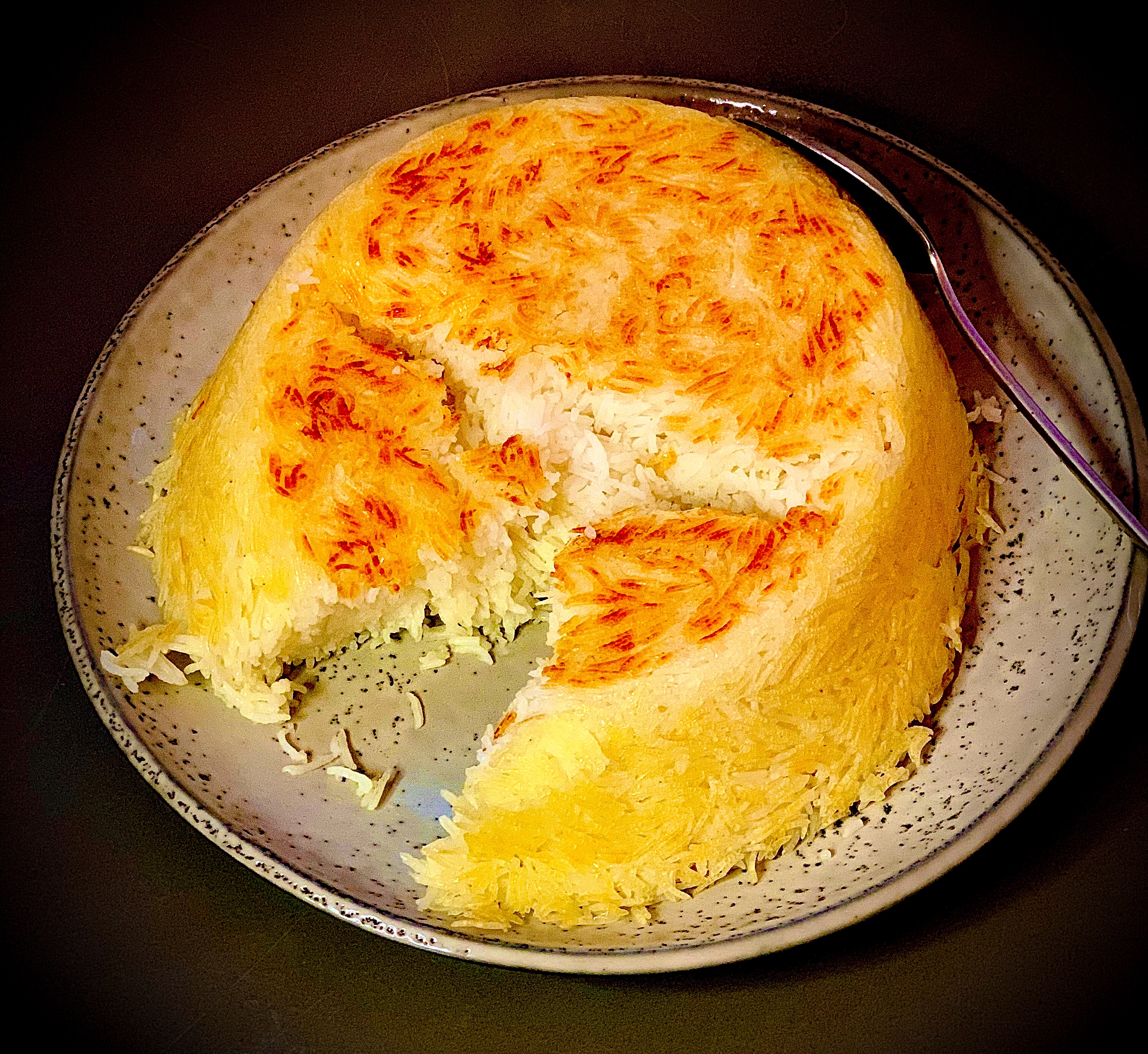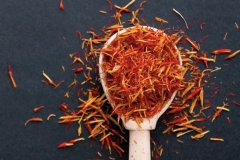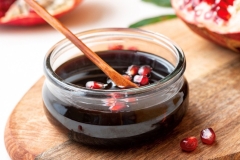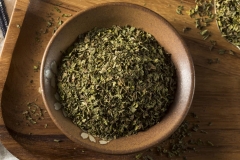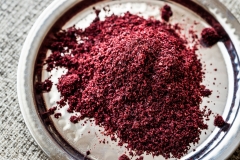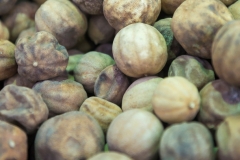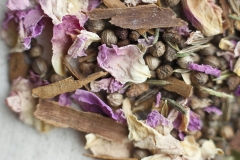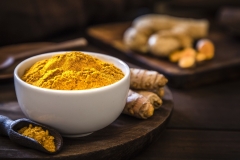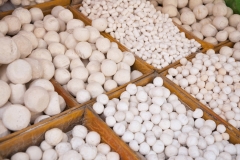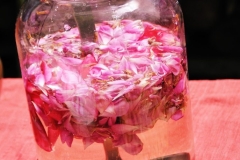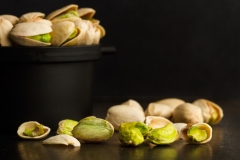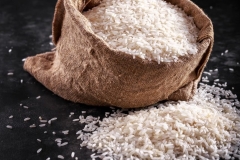Create rice with perfectly tender, separate and fluffy grains with a crunchy layer of crispy rice called Tahdig. This is the beloved way Iranians make rice. Once you master the skill, you are unlikely to make rice any other way!
What is Chelow?
Chelow is the name given to the white fluffy grains of rice either served with our kebabs or khoresh (stews) in Iranian cuisine. We also have Kateh, which refers to our version of easy-cook sticky rice, and polo, which refers to our rice cooked with vegetables, herbs and/or meat (similar to the Asian biryani).
Polo follows the same cooking procedure as chelow but has the added stage of preparing and cooking the ingredients to be mixed in to the rice. Kateh is simple as you boil and steam the rice without draining the water by letting it evaporate in the saucepan. Kateh tends to be reserved for family weekday meals.
What is Tahdig?
The common feature in the various Persian rice options is that they all yield the crispy rice, which forms at the bottom of the cooking pot, called ‘Tahdig’. Tahdig literally translated means ‘bottom of the pot’ and is the most cherished part of our meals. I don’t think I have ever met someone who dislikes tahdig!
Although kateh is the easiest way of cooking Persian-style rice it does not yield a tahdig as superior as chelow or polo. Therefore you are rewarded for going the extra mile with the slightly more complicated way of cooking rice.
To achieve the perfect fluffy rice and golden tahdig is a commitment. Despite this, even the veteran chelow and tahdig cooker sometimes has an off day with rice coming out a bit mushy and the tahdig burnt. So don’t be hard on yourself if you commit to this journey and it takes a while to master it. 

Tahdig Varieties
Now while chelow has a standard set of preparation and cooking steps, tahdig has a number of different options available. The most common are rice, potato or flatbread options.
As with the evolution of many cuisines, experiments have been undertaken to explore new ways of reinventing a classic. In the case of tahdig people have experimented with ingredients to see if they can create a new type of tahdig as good as the originals. I’ve seen tahdigs made with lettuce, fish and chicken.
Ingredients and Equipment to Make Chelow & Tahdig
Ingredients
- White long grain basmati rice – if you want to cook authentic Persian style rice this is the perfect rice to use. You can buy this from your local supermarket or local Middle-Eastern or Asian food shops. I recommend Tilda.
- Saffron – is needed for the Tahdig layer and potentially for serving it (see ‘How to serve Chelo & Tahdig’ below). Always grind your saffron strands into a fine powder after purchasing. For utilisation in Persian cooking, always bloom in water as directed in recipe.
- Salt – try not to baulk at the amount of salt used. Rice needs a lot of salt as it can be quite bland and the boiling stage washes a lot away. Taste a grain or two of your rice at step 6 of the recipe below. If it tastes too salty just pour a little cold water over your parboiled rice to wash some away.
- Neutral flavoured oil – used to create the Tahdig layer.
- Butter / ghee / or vegan equivalent – used for the Tahdig layer but also to drizzle over the rice pre steaming to create fluffy separate grains.
Equipment
- A good quality non-stick saucepan with a glass lid – essential kit to make the perfect chelow and tahdig, particularly if you want to flip the rice out as a contained cake-style rice encased in tahdig.
- A small-hole colander or sieve – to drain the rice.
- A clean tea towel – an absolute must as it aids the steaming of the rice by absorbing the water droplets, which would otherwise form on the lid of your saucepan and fall back on to the rice making it mushy.
Steps to Make Chelow
Chelow has a 6-step-process to follow, summarised below:
- Wash the rice. Removes the starch from the rice in order to assist in producing a tender fluffy grain. It also assists in the rice being more nutritious.
- Soak the rice. Not all consider this stage is necessary any more in light of the quality of long grain basmati rice available, however it is of note that some famous brands recommend soaking their rice for 30 minutes pre cooking. Soaking the rice promotes more thorough cooking by allowing moisture to reach the centre of the rice grain, it further improves its final texture, makes the grain less brittle and assists the rice to become more digestible.
- Par boil the rice until al dente. The first stage of the cooking process, which partially cooks the rice.
- Drain the rice. The rice does not continue to cook in the cooking liquid but is steamed with the water already absorbed into the rice from step 3 and an additional small amount of water.
- Prepare the Tahdig layer and then layer remaining rice on top. The tahdig layer is placed at the bottom of the pot on a little saffron water and oil and / or butter before the rest of the rice is layered on top. A little water and melted butter is poured over the rice to assist with the final cooking stage.
- Steam the rice. The rice is steamed with a lid covered in a tea-towel to create our beloved chelow and tahdig.
How to Serve Chelow & Tahdig
The recipe below sets out steps to serve the chelow and tahdig as a cake-style, tahdig encased rice as seen in the first set of pictures above.
For larger quantities, once the rice has cooked, I recommend spooning the rice out and serving it on one plate and then serving your tahdig separately on another dish. The latter is usually garnished with saffron coloured rice sprinkled on top (see picture). In my family we use a little rose water when blooming the saffron for the rice garnish as it adds a delicate floral note to the chelow, so if you want to present your rice this way then it is worth getting your hands on some rose water from your local Middle-Eastern food shop.
Simply mix a little cooked rice with saffron bloomed in a little water and rose water until it takes on a golden hue. Then sprinkle the saffron rice on top of the plain white rice and then serve.

As a final note, the primary recipe below is to make chelow with rice tahdig. Refer to the ‘Alternative Step’ sections below for guidance on how to make potato or flatbread tahdig.
Check out my Reel on How to Cook Chelow and Tahdig
Chelow and Tahdig
Ingredients
- 2 cups white long grain Basmati rice (standard UK measuring cup capacity 250 ml - approx 400 grams of rice)
- 2 tbsp salt
- Water (as directed below)
- 1/8 tsp ground saffron bloomed in 2 tbsp of water for the tahdig
- 2 tbsp vegetable oil plus extra if you are making potato or flatbread tahdig as per 'Alternative Step' sections below
- 2 to 3 tbsp ghee / butter / vegan equivalent
Instructions
Wash and Soak the Rice
- Wash rice in cold water until water runs clear. Be gentle, otherwise you will damage and break the grains.
- Place rice with 1 tbsp of salt in a bowl and pour in cold water to cover up to 2 inches above the top. Leave to soak for a minimum of 30 mins (I leave mine overnight and cook the rice during the afternoon of the day after).
Parboil the Rice
- Fill a large non-stick saucepan (minimum capacity 2.5 litres) with approximately 1.5 litres of water and 1 tbsp of salt. Place over high heat and bring water to a boil.
- Drain the rice and then add to the saucepan. Gently stir to make sure it does not stick to the pan.
- Stay with the saucepan and do not leave it at this stage. It is crucial that you remove the rice and drain it at the right time. Every minute give it a gentle stir and take a grain and check the texture - either between your fingers or using your teeth. What you want is the grain to be soft on the outer layer but still firm in the centre. It can take any time from 3 to 7 minutes with the quantity in this recipe.
- Once the parboiled rice reaches the correct texture, turn your heat off and drain in a colander or sieve. Sprinkle a little cold water to halt the cooking process. Taste the rice - if it is very salty then rinse it further with a little water.
Prepare the Tahdig Layer
- Place the empty saucepan on your stove.
- Add 2 tbsp of oil and 1 tbsp of butter / ghee / vegan equivalent to the pan and place on a low heat to melt. Then turn the heat off. (See * below for alternative tahdig layers - potato or flatbread).
- Add your bloomed saffron to the saucepan and mix with the oil to distribute evenly (this will give a lovely golden colour to your tahdig).
- To make your tahdig spoon about a 1-inch layer of rice into the saucepan and gently stir to mix with the saffron oil to ensure colour is distributed evenly. Be careful not to break the grains. Then pat down flat with the back of a spoon.
- Then layer the remaining rice and gently pat down to the shape of the saucepan. Take the end of a tablespoon and gently poke about 5 small holes in the rice to allow steam to escape while cooking. Then pour over 2 tbsp of cold water.
- Drizzle 1 to 2 tbsp of melted ghee / butter / vegan equivalent over the rice.
Steam the Rice
- Place your glass lid on the saucepan and turn the heat to the highest setting. Once you start to see steam rise from the rice (your glass lid will start to get clear from the steam and droplets of water will start to form on the lid - it is perfectly fine to have a little look under the lid now and again to check the steam situation) lower the heat to the minimum flame or equivalent on your cooker. Cover the lid with a tea towel (making sure it is not a fire risk) and replace the lid on the saucepan.
- Allow to steam for a minimum of 45 mins to get a crunchy and thick layer of tahdig.
Serve the Chelow & Tahdig
- When the cooking time is over turn off the heat and remove the lid from the saucepan. Take a serving dish that covers the opening of the saucepan and place it on top. Flip the rice out onto the dish and serve with either a khoresh, kabab, curry or any other dish.
*Alternative Tahdig - Potato Tahdig
- If you are making potato tahdig, you will need 1 medium-sized potato peeled and sliced into 1.5 cm thick discs. Place the sliced potatoes into a bowl of water to wash off excess starch - this will help during the crisping process while the rice steams. It will also stop the potatoes turning brown as you get the rice ready to steam.
- For preparing a potato Tahdig layer - add an extra tablespoon of vegetable oil to the bottom of your pot then layer your potatoes at the bottom of the pan on top of the saffron oil (try not to overlap them so they all cook through evenly and crisp up) and then layer your rice on top and pat down to fill any gaps between the potatoes. Then follow subsequent steps of the recipe.
*Alternative Tahdig - Flatbread Tahdig
- If you are making flatbread tahdig, you will need 1 medium Middle-Eastern style flatbread like lavash or 1 medium white tortilla.
- For preparing a flatbread Tahdig - use the flatbread to cover the bottom of the pan or you can cut shapes into it and layer the bottom surface of the saucepan only. Either way, before layering your flatbread, take a pastry brush and coat your flatbread generously with vegetable oil and then lay it on the saffron oil. Then layer your rice on top and follow the subsequent steps of the recipe. If you are using the whole flatbread to cover the bottom of the saucepan, without cutting shapes, be a little cautious with the timing on lowering the heat to steam the rice as the flatbread can burn quite quickly. As soon as you see steam creeping round the edges of the bread, then turn down the heat and place the lid wrapped with a tea towel on the saucepan. Follow the subsequent steps of the recipe.




